Project Management: A Case Study of Cyber Security Physical System
VerifiedAdded on 2023/06/12
|5
|1274
|61
Case Study
AI Summary
This case study delves into the integration of cyber security with physical systems, highlighting the capabilities of adding intelligence to social life by associating the virtual and physical worlds. It discusses the integration of physical devices like cameras and sensors with cyber security compone...
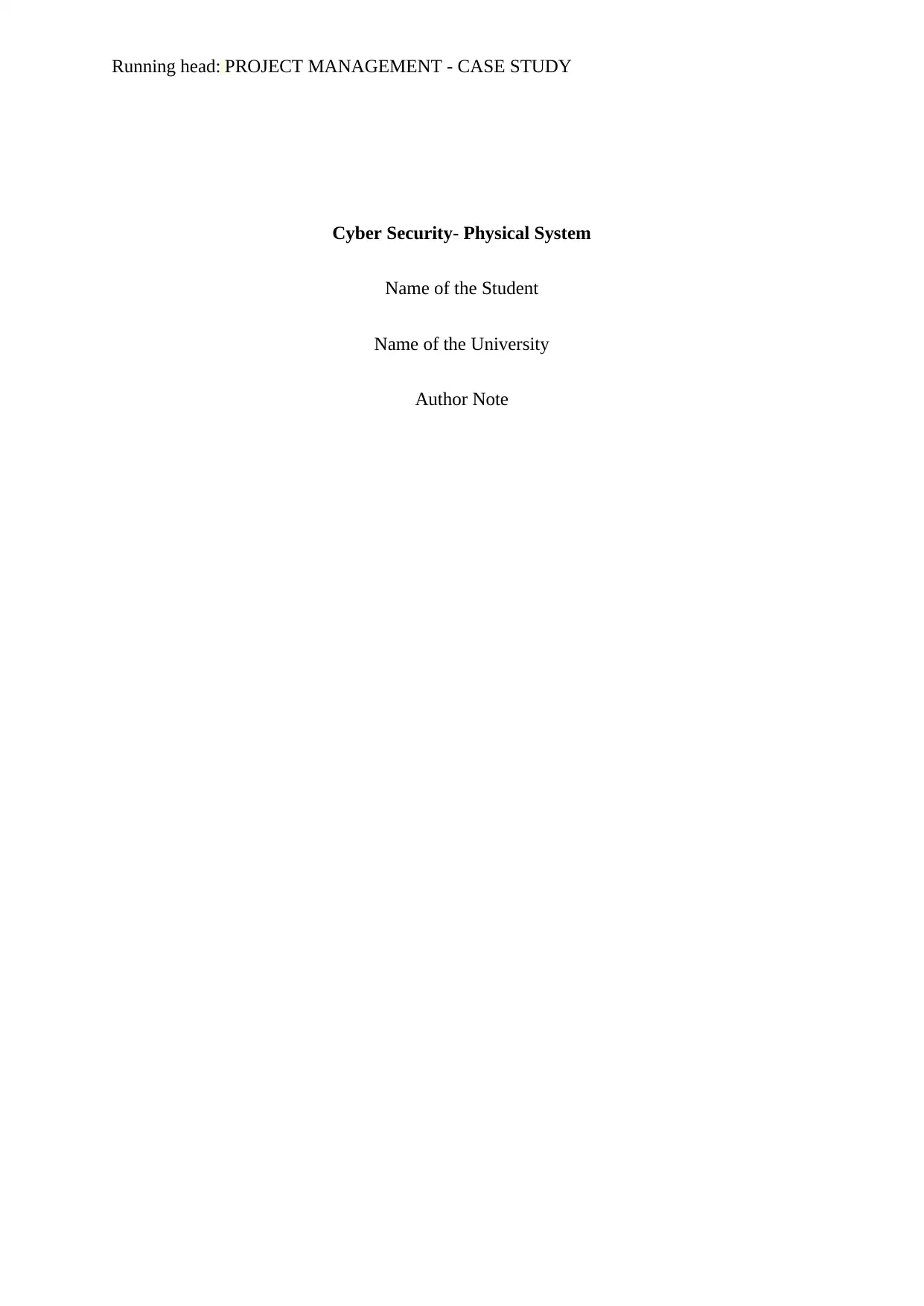
Running head: PROJECT MANAGEMENT - CASE STUDY
Cyber Security- Physical System
Name of the Student
Name of the University
Author Note
Cyber Security- Physical System
Name of the Student
Name of the University
Author Note
Paraphrase This Document
Need a fresh take? Get an instant paraphrase of this document with our AI Paraphraser
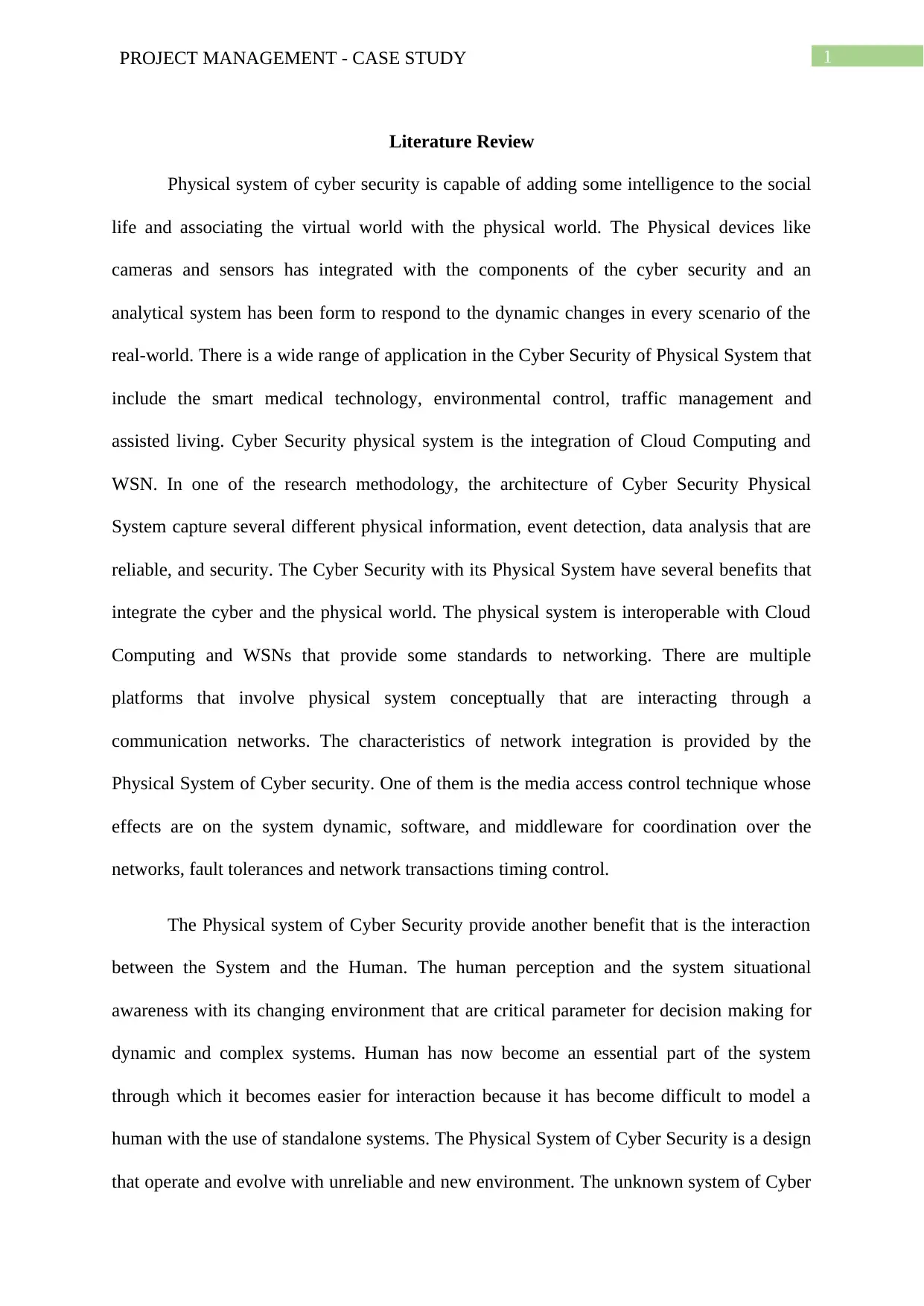
1PROJECT MANAGEMENT - CASE STUDY
Literature Review
Physical system of cyber security is capable of adding some intelligence to the social
life and associating the virtual world with the physical world. The Physical devices like
cameras and sensors has integrated with the components of the cyber security and an
analytical system has been form to respond to the dynamic changes in every scenario of the
real-world. There is a wide range of application in the Cyber Security of Physical System that
include the smart medical technology, environmental control, traffic management and
assisted living. Cyber Security physical system is the integration of Cloud Computing and
WSN. In one of the research methodology, the architecture of Cyber Security Physical
System capture several different physical information, event detection, data analysis that are
reliable, and security. The Cyber Security with its Physical System have several benefits that
integrate the cyber and the physical world. The physical system is interoperable with Cloud
Computing and WSNs that provide some standards to networking. There are multiple
platforms that involve physical system conceptually that are interacting through a
communication networks. The characteristics of network integration is provided by the
Physical System of Cyber security. One of them is the media access control technique whose
effects are on the system dynamic, software, and middleware for coordination over the
networks, fault tolerances and network transactions timing control.
The Physical system of Cyber Security provide another benefit that is the interaction
between the System and the Human. The human perception and the system situational
awareness with its changing environment that are critical parameter for decision making for
dynamic and complex systems. Human has now become an essential part of the system
through which it becomes easier for interaction because it has become difficult to model a
human with the use of standalone systems. The Physical System of Cyber Security is a design
that operate and evolve with unreliable and new environment. The unknown system of Cyber
Literature Review
Physical system of cyber security is capable of adding some intelligence to the social
life and associating the virtual world with the physical world. The Physical devices like
cameras and sensors has integrated with the components of the cyber security and an
analytical system has been form to respond to the dynamic changes in every scenario of the
real-world. There is a wide range of application in the Cyber Security of Physical System that
include the smart medical technology, environmental control, traffic management and
assisted living. Cyber Security physical system is the integration of Cloud Computing and
WSN. In one of the research methodology, the architecture of Cyber Security Physical
System capture several different physical information, event detection, data analysis that are
reliable, and security. The Cyber Security with its Physical System have several benefits that
integrate the cyber and the physical world. The physical system is interoperable with Cloud
Computing and WSNs that provide some standards to networking. There are multiple
platforms that involve physical system conceptually that are interacting through a
communication networks. The characteristics of network integration is provided by the
Physical System of Cyber security. One of them is the media access control technique whose
effects are on the system dynamic, software, and middleware for coordination over the
networks, fault tolerances and network transactions timing control.
The Physical system of Cyber Security provide another benefit that is the interaction
between the System and the Human. The human perception and the system situational
awareness with its changing environment that are critical parameter for decision making for
dynamic and complex systems. Human has now become an essential part of the system
through which it becomes easier for interaction because it has become difficult to model a
human with the use of standalone systems. The Physical System of Cyber Security is a design
that operate and evolve with unreliable and new environment. The unknown system of Cyber
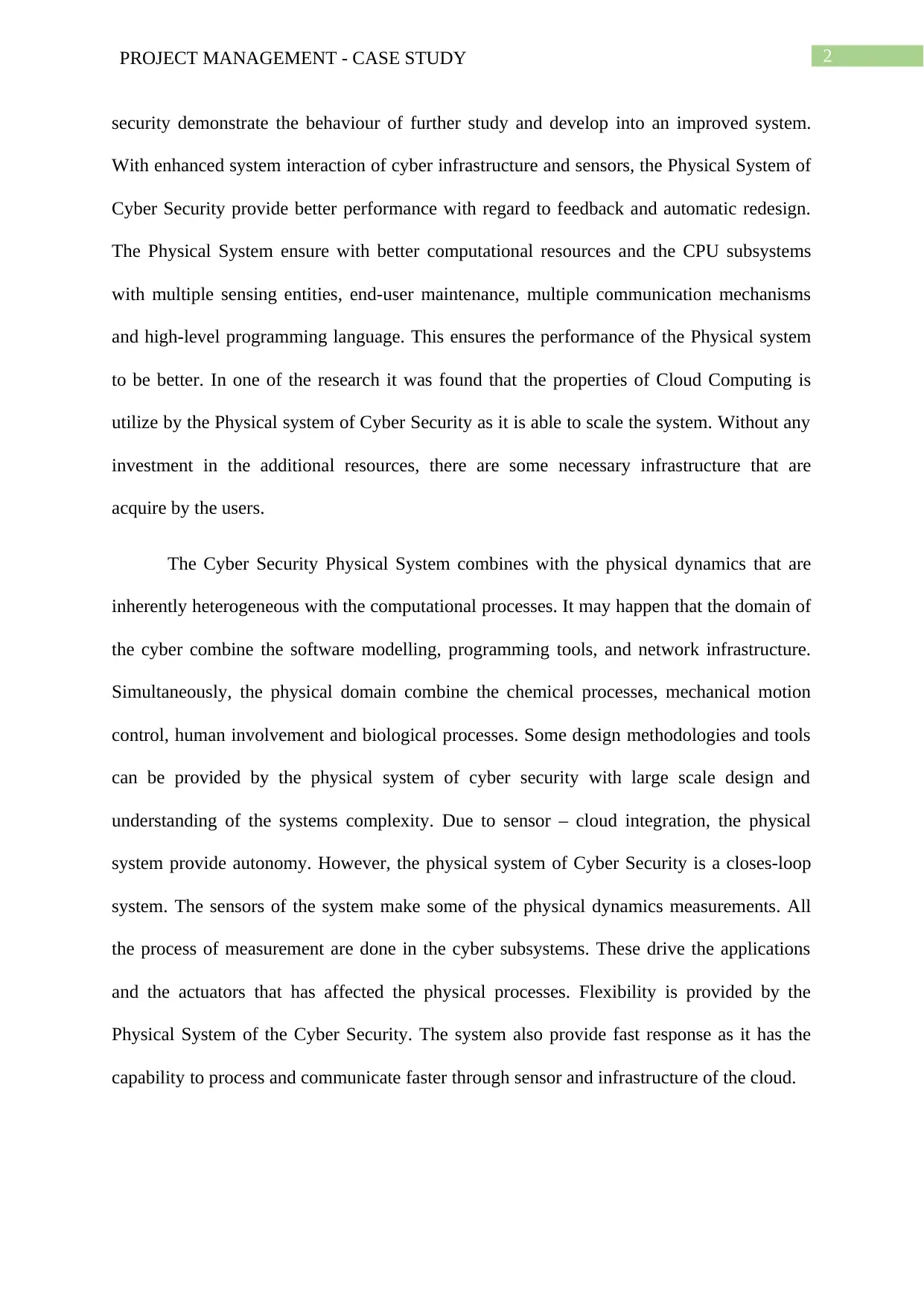
2PROJECT MANAGEMENT - CASE STUDY
security demonstrate the behaviour of further study and develop into an improved system.
With enhanced system interaction of cyber infrastructure and sensors, the Physical System of
Cyber Security provide better performance with regard to feedback and automatic redesign.
The Physical System ensure with better computational resources and the CPU subsystems
with multiple sensing entities, end-user maintenance, multiple communication mechanisms
and high-level programming language. This ensures the performance of the Physical system
to be better. In one of the research it was found that the properties of Cloud Computing is
utilize by the Physical system of Cyber Security as it is able to scale the system. Without any
investment in the additional resources, there are some necessary infrastructure that are
acquire by the users.
The Cyber Security Physical System combines with the physical dynamics that are
inherently heterogeneous with the computational processes. It may happen that the domain of
the cyber combine the software modelling, programming tools, and network infrastructure.
Simultaneously, the physical domain combine the chemical processes, mechanical motion
control, human involvement and biological processes. Some design methodologies and tools
can be provided by the physical system of cyber security with large scale design and
understanding of the systems complexity. Due to sensor – cloud integration, the physical
system provide autonomy. However, the physical system of Cyber Security is a closes-loop
system. The sensors of the system make some of the physical dynamics measurements. All
the process of measurement are done in the cyber subsystems. These drive the applications
and the actuators that has affected the physical processes. Flexibility is provided by the
Physical System of the Cyber Security. The system also provide fast response as it has the
capability to process and communicate faster through sensor and infrastructure of the cloud.
security demonstrate the behaviour of further study and develop into an improved system.
With enhanced system interaction of cyber infrastructure and sensors, the Physical System of
Cyber Security provide better performance with regard to feedback and automatic redesign.
The Physical System ensure with better computational resources and the CPU subsystems
with multiple sensing entities, end-user maintenance, multiple communication mechanisms
and high-level programming language. This ensures the performance of the Physical system
to be better. In one of the research it was found that the properties of Cloud Computing is
utilize by the Physical system of Cyber Security as it is able to scale the system. Without any
investment in the additional resources, there are some necessary infrastructure that are
acquire by the users.
The Cyber Security Physical System combines with the physical dynamics that are
inherently heterogeneous with the computational processes. It may happen that the domain of
the cyber combine the software modelling, programming tools, and network infrastructure.
Simultaneously, the physical domain combine the chemical processes, mechanical motion
control, human involvement and biological processes. Some design methodologies and tools
can be provided by the physical system of cyber security with large scale design and
understanding of the systems complexity. Due to sensor – cloud integration, the physical
system provide autonomy. However, the physical system of Cyber Security is a closes-loop
system. The sensors of the system make some of the physical dynamics measurements. All
the process of measurement are done in the cyber subsystems. These drive the applications
and the actuators that has affected the physical processes. Flexibility is provided by the
Physical System of the Cyber Security. The system also provide fast response as it has the
capability to process and communicate faster through sensor and infrastructure of the cloud.
⊘ This is a preview!⊘
Do you want full access?
Subscribe today to unlock all pages.

Trusted by 1+ million students worldwide
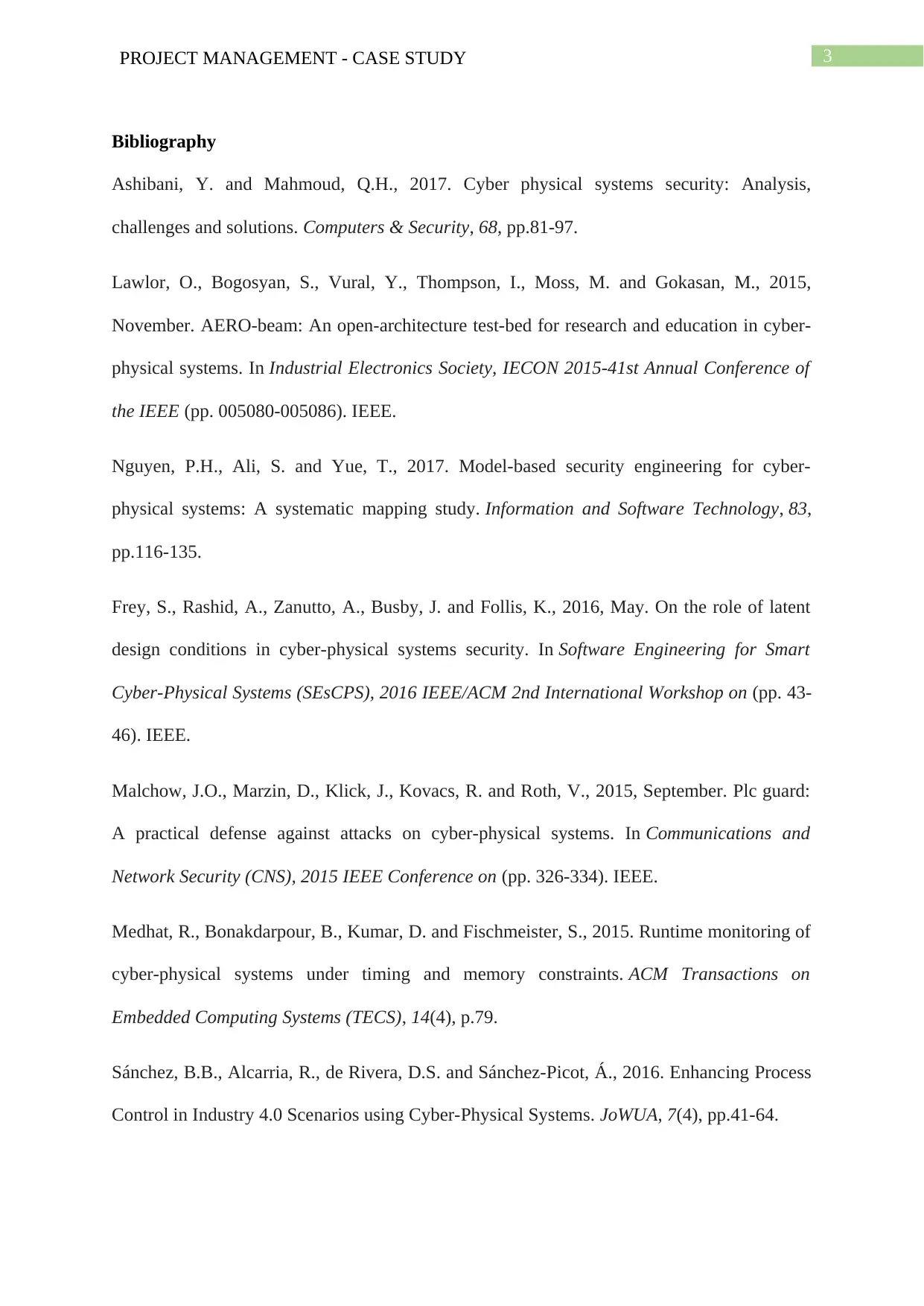
3PROJECT MANAGEMENT - CASE STUDY
Bibliography
Ashibani, Y. and Mahmoud, Q.H., 2017. Cyber physical systems security: Analysis,
challenges and solutions. Computers & Security, 68, pp.81-97.
Lawlor, O., Bogosyan, S., Vural, Y., Thompson, I., Moss, M. and Gokasan, M., 2015,
November. AERO-beam: An open-architecture test-bed for research and education in cyber-
physical systems. In Industrial Electronics Society, IECON 2015-41st Annual Conference of
the IEEE (pp. 005080-005086). IEEE.
Nguyen, P.H., Ali, S. and Yue, T., 2017. Model-based security engineering for cyber-
physical systems: A systematic mapping study. Information and Software Technology, 83,
pp.116-135.
Frey, S., Rashid, A., Zanutto, A., Busby, J. and Follis, K., 2016, May. On the role of latent
design conditions in cyber-physical systems security. In Software Engineering for Smart
Cyber-Physical Systems (SEsCPS), 2016 IEEE/ACM 2nd International Workshop on (pp. 43-
46). IEEE.
Malchow, J.O., Marzin, D., Klick, J., Kovacs, R. and Roth, V., 2015, September. Plc guard:
A practical defense against attacks on cyber-physical systems. In Communications and
Network Security (CNS), 2015 IEEE Conference on (pp. 326-334). IEEE.
Medhat, R., Bonakdarpour, B., Kumar, D. and Fischmeister, S., 2015. Runtime monitoring of
cyber-physical systems under timing and memory constraints. ACM Transactions on
Embedded Computing Systems (TECS), 14(4), p.79.
Sánchez, B.B., Alcarria, R., de Rivera, D.S. and Sánchez-Picot, Á., 2016. Enhancing Process
Control in Industry 4.0 Scenarios using Cyber-Physical Systems. JoWUA, 7(4), pp.41-64.
Bibliography
Ashibani, Y. and Mahmoud, Q.H., 2017. Cyber physical systems security: Analysis,
challenges and solutions. Computers & Security, 68, pp.81-97.
Lawlor, O., Bogosyan, S., Vural, Y., Thompson, I., Moss, M. and Gokasan, M., 2015,
November. AERO-beam: An open-architecture test-bed for research and education in cyber-
physical systems. In Industrial Electronics Society, IECON 2015-41st Annual Conference of
the IEEE (pp. 005080-005086). IEEE.
Nguyen, P.H., Ali, S. and Yue, T., 2017. Model-based security engineering for cyber-
physical systems: A systematic mapping study. Information and Software Technology, 83,
pp.116-135.
Frey, S., Rashid, A., Zanutto, A., Busby, J. and Follis, K., 2016, May. On the role of latent
design conditions in cyber-physical systems security. In Software Engineering for Smart
Cyber-Physical Systems (SEsCPS), 2016 IEEE/ACM 2nd International Workshop on (pp. 43-
46). IEEE.
Malchow, J.O., Marzin, D., Klick, J., Kovacs, R. and Roth, V., 2015, September. Plc guard:
A practical defense against attacks on cyber-physical systems. In Communications and
Network Security (CNS), 2015 IEEE Conference on (pp. 326-334). IEEE.
Medhat, R., Bonakdarpour, B., Kumar, D. and Fischmeister, S., 2015. Runtime monitoring of
cyber-physical systems under timing and memory constraints. ACM Transactions on
Embedded Computing Systems (TECS), 14(4), p.79.
Sánchez, B.B., Alcarria, R., de Rivera, D.S. and Sánchez-Picot, Á., 2016. Enhancing Process
Control in Industry 4.0 Scenarios using Cyber-Physical Systems. JoWUA, 7(4), pp.41-64.
Paraphrase This Document
Need a fresh take? Get an instant paraphrase of this document with our AI Paraphraser
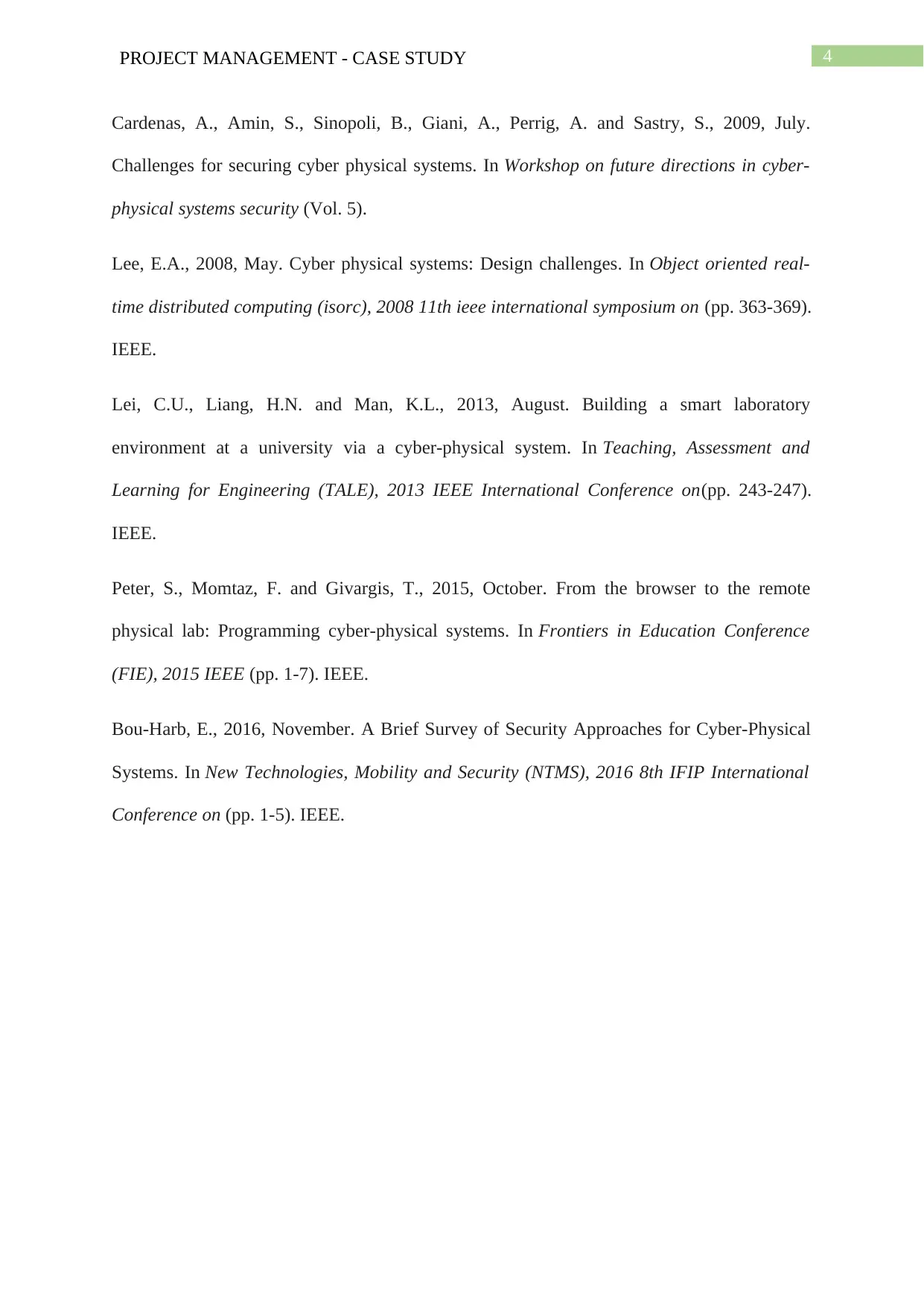
4PROJECT MANAGEMENT - CASE STUDY
Cardenas, A., Amin, S., Sinopoli, B., Giani, A., Perrig, A. and Sastry, S., 2009, July.
Challenges for securing cyber physical systems. In Workshop on future directions in cyber-
physical systems security (Vol. 5).
Lee, E.A., 2008, May. Cyber physical systems: Design challenges. In Object oriented real-
time distributed computing (isorc), 2008 11th ieee international symposium on (pp. 363-369).
IEEE.
Lei, C.U., Liang, H.N. and Man, K.L., 2013, August. Building a smart laboratory
environment at a university via a cyber-physical system. In Teaching, Assessment and
Learning for Engineering (TALE), 2013 IEEE International Conference on(pp. 243-247).
IEEE.
Peter, S., Momtaz, F. and Givargis, T., 2015, October. From the browser to the remote
physical lab: Programming cyber-physical systems. In Frontiers in Education Conference
(FIE), 2015 IEEE (pp. 1-7). IEEE.
Bou-Harb, E., 2016, November. A Brief Survey of Security Approaches for Cyber-Physical
Systems. In New Technologies, Mobility and Security (NTMS), 2016 8th IFIP International
Conference on (pp. 1-5). IEEE.
Cardenas, A., Amin, S., Sinopoli, B., Giani, A., Perrig, A. and Sastry, S., 2009, July.
Challenges for securing cyber physical systems. In Workshop on future directions in cyber-
physical systems security (Vol. 5).
Lee, E.A., 2008, May. Cyber physical systems: Design challenges. In Object oriented real-
time distributed computing (isorc), 2008 11th ieee international symposium on (pp. 363-369).
IEEE.
Lei, C.U., Liang, H.N. and Man, K.L., 2013, August. Building a smart laboratory
environment at a university via a cyber-physical system. In Teaching, Assessment and
Learning for Engineering (TALE), 2013 IEEE International Conference on(pp. 243-247).
IEEE.
Peter, S., Momtaz, F. and Givargis, T., 2015, October. From the browser to the remote
physical lab: Programming cyber-physical systems. In Frontiers in Education Conference
(FIE), 2015 IEEE (pp. 1-7). IEEE.
Bou-Harb, E., 2016, November. A Brief Survey of Security Approaches for Cyber-Physical
Systems. In New Technologies, Mobility and Security (NTMS), 2016 8th IFIP International
Conference on (pp. 1-5). IEEE.
1 out of 5
Related Documents
Your All-in-One AI-Powered Toolkit for Academic Success.
+13062052269
info@desklib.com
Available 24*7 on WhatsApp / Email
![[object Object]](/_next/static/media/star-bottom.7253800d.svg)
Unlock your academic potential
© 2024 | Zucol Services PVT LTD | All rights reserved.





